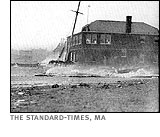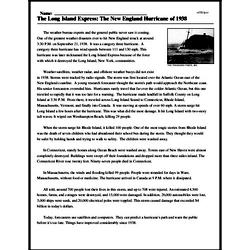The Long Island Express: The New England Hurricane of 1938
The weather bureau experts and the general public never saw it coming. One of the greatest weather disasters ever to hit New England struck at around 3:30 P.M. on September 21, 1938. It was a category three hurricane. A category three hurricane has wind speeds between 111 and 130 mph. This hurricane was later nicknamed the Long Island Express because of the force with which it destroyed the Long Island, New York, communities.
Weather satellites, weather radar, and offshore weather buoys did not exist in 1938. Storms were tracked by radio signals. The storm was first located over the Atlantic Ocean east of the New England coastline. A young research forecaster thought the storm's path would approach the Northeast coast. His senior forecasters overruled him. Hurricanes rarely travel that far over the colder Atlantic Ocean, but this one traveled so rapidly that it was too late for a warning. The hurricane made landfall in Suffolk County on Long Island at 3:30 P.M. From there, it traveled across Long Island Sound to Connecticut, Rhode Island, Massachusetts, Vermont, and finally into Canada. It was moving at speeds of over 60 mph. A storm surge hit Long Island a few hours after the hurricane. This was what did the most damage. It hit Long Island with two-story tall waves. It wiped out Westhampton Beach, killing 29 people.
When the storm surge hit Rhode Island, it killed 100 people. One of the most tragic stories from Rhode Island was the death of seven children who had abandoned their school bus during the storm. They thought they would be safer by holding hands and trying to walk to safety. The children were washed away.




